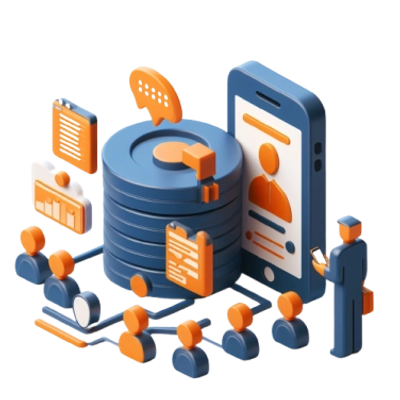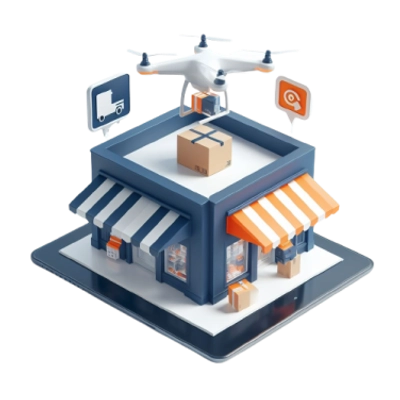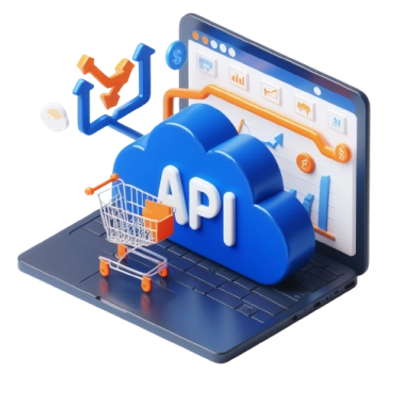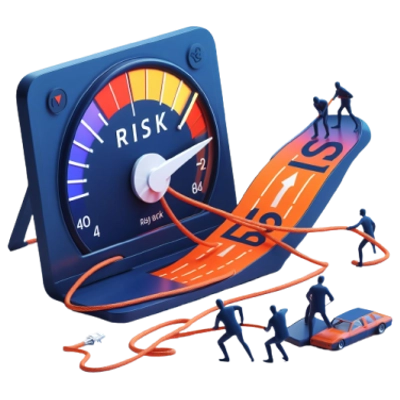
- Personalized Shopping Experiences
- Imagine tailoring product recommendations and marketing campaigns based on your customers' preferences and past behavior. With unified customer data, we make personalization a reality, increasing your conversion rates and customer loyalty.
- Smooth Customer Journeys
- Customers interact with your brand across various platforms and channels. Our service ensures that your customer data is consistent and integrated across all touchpoints, providing a seamless and unified customer experience.
- Exceptional Customer Support
- Empower your support teams with a complete 360-degree view of each customer. Armed with this knowledge, your agents can deliver personalized and efficient assistance, resulting in delighted customers who keep coming back.
- Optimized Marketing Strategies
- Get the most out of your marketing efforts by leveraging unified customer data. Our solution helps you segment your customer base effectively, target specific audiences, and optimize your marketing campaigns for maximum ROI.
- Smart Inventory Management
- Keeping the right inventory levels is crucial. Unified customer data helps you anticipate demand fluctuations, optimize your stock, and minimize the risk of stockouts or overstocking, all leading to improved profitability.
- Fraud Detection
- Protect your business from fraudulent activities with our unified customer data approach. By understanding typical customer behavior, we can flag suspicious transactions in real time, safeguarding your revenue.
- Data-Driven Decision-Making
- Our service provides you with deep insights into customer behavior, purchase patterns, and emerging trends. Leverage these insights to make informed, data-driven decisions and stay ahead of your competition.
- Compliance Assurance
- Navigate the complex landscape of data privacy regulations with ease. Our centralized data management helps you ensure compliance with laws like GDPR or CCPA, giving you peace of mind.
- Competitive Edge
- Gain a significant competitive advantage by harnessing the power of unified customer data. Adapt to changing market dynamics, meet customer expectations, and outshine your competition.
In the dynamic world of digital commerce, having a consolidated and comprehensive view of your customers is the key to thriving. Our digital commerce service is designed to harness the immense potential of unified customer data, and here's why it's crucial for your success:

- Multi-channel Integration
-
- Technical Component: Seamless API integration with sales channels.
- Advantage: Synchronized inventory data across channels, reducing overselling.
- Inventory Optimization Algorithms
-
- Technical Component: Complex algorithms for reorder point optimization.
- Advantage: Cost savings and efficient stock management.
- Data Analytics for Supplier Management
-
- Technical Component: Supplier performance analytics.
- Advantage: Informed supplier decisions and supply chain management.
- Smart Warehousing
-
- Technical Component: IoT, smart sensors, and automation.
- Advantage: Optimized storage, reduced costs, and improved accuracy.
- Mobile Inventory Management Apps
-
- Technical Component: User-friendly mobile apps.
- Advantage: Remote inventory management for on-the-go decisions.
- Data Security and Compliance
-
- Technical Component: Robust security measures.
- Advantage: Protection of sensitive data and compliance with regulations.
In the world of digital commerce, efficient inventory management is critical. Robust digital inventory management solutions are reshaping the landscape, incorporating key technical aspects:

- Order Management System (OMS)
-
- Integration: Develop an OMS that seamlessly integrates with your e-commerce platform and other sales channels.
- Benefits: A unified OMS allows for real-time order processing, inventory tracking, and order status updates, ensuring a smooth and consistent customer experience.
- Automated Order Routing
-
- Technology: Implement intelligent algorithms for order routing based on factors like location, product availability, and shipping options.
- Advantages: Efficient distribution of orders to the nearest warehouses or fulfillment centers reduces shipping times and costs.
- Inventory Visibility
-
- Tools: Develop digital tools, such as RFID, IoT sensors, and barcode scanning, to provide real-time visibility into inventory levels.
- Benefits: Accurate inventory data helps prevent stockouts, overstocking, and enables proactive restocking decisions.
- Warehouse Automation
-
- Automation: Invest in robotics, automated conveyors, and sorting systems for efficient order picking and packing.
- Advantages: Reduced labor costs, increased order accuracy, and faster order fulfillment.
- Predictive Analytics
-
- Analytics: Utilize machine learning and predictive analytics to forecast demand and optimize stock levels.
- Benefits: Minimize excess inventory, reduce carrying costs, and ensure products are readily available when needed.
- Last-Mile Delivery Optimization
-
- Routing Algorithms: Develop algorithms that optimize delivery routes and methods for the last mile.
- Advantages: Faster, cost-effective, and environmentally-friendly delivery options enhance the customer experience.
- Customer Communication Platforms
-
- Chatbots and Notifications: Implement chatbots and automated notifications to keep customers informed about their order status.
- Benefits: Enhance transparency and reduce customer inquiries, leading to higher satisfaction.
- Returns Management System
-
- Technology: Create a digital returns management system with a user-friendly interface.
- Advantages: Simplify the returns process, improve customer satisfaction, and reduce return-related costs.
In today's fast-paced digital commerce landscape, order fulfillment is a critical component of customer satisfaction and business success. To meet the increasing demands of consumers, businesses are turning to innovative digital services to streamline and enhance the order fulfillment process. Here's a guide on developing digital services for order fulfillment excellence:

- Customer-Centric Approach
- Cross-channel commerce puts the customer at the center. It acknowledges that customers want the flexibility to shop online, in-store, via mobile apps, or through social media, and it caters to those preferences.
- Enhanced Customer Experience
- It provides a consistent and personalized shopping experience regardless of the channel. Customers can begin their shopping journey on one channel and seamlessly transition to another without disruption.
- Increased Sales Opportunities
- By offering multiple sales channels, businesses expand their reach and capture potential customers who prefer specific platforms or methods of shopping.
- Data-Driven Insights
- Cross-channel commerce generates a wealth of data, allowing businesses to gain deeper insights into customer behavior, preferences, and trends, which can inform marketing and inventory decisions.
In the modern retail landscape, consumers have the power to shop wherever, whenever, and however they choose. Cross-channel commerce is the strategy that recognizes and embraces this reality, offering a seamless and integrated shopping experience across various channels and touchpoints. Here's why cross-channel commerce is crucial and how it works:
Why Cross-Channel Commerce Matters:
- Unified Inventory Management
- A central inventory management system ensures that stock levels, product information, and pricing remain consistent across all channels.
- Omnichannel Marketing
- Implement marketing strategies that engage customers across various channels, such as email, social media, SMS, and more. Personalization is key to tailoring messages to each channel.
- Seamless Customer Journey
- Ensure that customers can start, continue, and complete their shopping journey effortlessly as they switch between channels. This includes offering options like buy online, pick up in-store (BOPIS) and ship-to-store.
- Integrated Technology
- Invest in integrated technology solutions that synchronize data, such as Customer Relationship Management (CRM) systems, Enterprise Resource Planning (ERP) software, and Customer Data Platforms (CDP).
- Mobile Optimization
- Given the rise of mobile commerce, optimize your online presence for mobile devices, ensuring that your website and apps are user-friendly and responsive.
- In-Store Technology
- Implement in-store technologies like digital kiosks, mobile point-of-sale systems, and RFID tags to bridge the gap between online and offline shopping.
- Analytics and Insights
- Leverage data analytics to monitor customer behavior and track the performance of various channels, allowing for continuous optimization.
- Inventory Visibility
- Provide customers with real-time inventory visibility, so they know whether a product is available in a nearby store or for online purchase.
How Cross-Channel Commerce Works:

- Scalability through a Modular Approach
-
- Modular Expansion: API integration allows businesses to adopt a modular approach to technology. They can effortlessly incorporate new features, services, and applications into their existing digital commerce infrastructure without the need for time-consuming
- Payment Integration for Seamless Transactions
-
- Payment Gateway Integration: API integration seamlessly connects your e-commerce platform to payment gateways, ensuring secure and efficient transactions. Notable examples include PayPal, Stripe, and Square, which offer a variety of payment options to cater to customer preferences.
- CRM Integration for Enhanced Customer Insights
-
- Salesforce Integration: Integrating Salesforce CRM with your digital commerce platform empowers you with deep customer insights, sales automation, and customer engagement tools. This integration enables a 360-degree view of customer data, allowing for highly targeted marketing campaigns and personalized shopping experiences.
- HubSpot Integration: HubSpot's CRM integration enables businesses to track and manage customer interactions seamlessly. It offers marketing automation, email campaigns, and lead nurturing, all of which can enhance customer engagement and drive sales growth.
- Streamlining Inventory Management
-
- Inventory Control: API integration centralizes inventory management across multiple sales channels, allowing real-time updates and synchronization. This ensures accurate stock levels and minimizes the risk of overselling or stockouts.
- Enhancing Customer Loyalty
-
- Loyalty Program Integration: API integration enables the implementation of customer loyalty programs, which can be seamlessly managed across platforms. These programs encourage repeat business and enhance customer retention.
- Analytics for Data-Driven Decisions
-
- Analytics Integration: Data analytics tools like Google Analytics or Adobe Analytics can be integrated with your digital commerce platform to gather insights into customer behavior, sales trends, and website performance. This data informs strategic decision-making and marketing efforts.
- Seamless Customer Experience
-
- Mobile App Integration: APIs allow businesses to integrate their e-commerce platforms with mobile apps, providing a convenient and consistent shopping experience for customers on their preferred devices.
- Global Expansion with Multilingual and Multi-currency Support
-
- Localization: API integration enables businesses to offer multilingual websites and support multiple currencies, catering to a global customer base.
In the digital commerce landscape, API (Application Programming Interface) integration serves as the linchpin for businesses seeking to elevate their operations and customer experiences. Here's how API integration fuels efficiency and innovation, with a specific focus on scalability, payment integration, and CRM integration:

- Scalable Frontend
-
- Content Delivery Networks (CDNs): Implement CDNs like Cloudflare, Akamai, or AWS CloudFront to distribute content geographically. CDNs reduce server load by caching and delivering static assets from the nearest server location, ensuring faster load times for users worldwide.
- Progressive Web Apps (PWAs): Develop PWAs that provide a seamless and responsive user experience across different devices and network conditions. PWAs leverage service workers to cache assets and enable offline access, reducing server dependency.
- Responsive Design: Utilize responsive web design principles to ensure your website adapts to various screen sizes and devices, eliminating the need for separate mobile and desktop versions.
- Scalable Backend
-
- Microservices Architecture: Adopt a microservices-based approach to break down your backend into smaller, independent services. Each service can be developed, deployed, and scaled independently to accommodate varying workloads.
- Serverless Computing: Consider serverless platforms like AWS Lambda, Azure Functions, or Google Cloud Functions. Serverless allows you to focus on code development while the platform automatically handles server provisioning and scaling based on demand.
- Containerization and Orchestration: Use containerization technologies like Docker and orchestration tools like Kubernetes to manage and scale containerized applications effectively. Containers provide consistency and portability, making it easier to scale services across different environments.
- Database Scalability
-
- Horizontal Scaling: Implement database sharding or partitioning to distribute data across multiple servers or instances. This horizontal scaling approach allows databases to handle increased data loads efficiently.
- NoSQL Databases: Consider NoSQL databases like MongoDB, Cassandra, or Amazon DynamoDB for their ability to scale horizontally and handle large volumes of unstructured data.
- Infrastructure Scalability
-
- Auto-Scaling in Cloud Environments: Cloud providers like AWS, Azure, and Google Cloud offer auto-scaling capabilities. Configure rules and policies to automatically add or remove resources (e.g., virtual machines) based on workload demands.
- Load Balancers: Deploy load balancers, such as AWS Elastic Load Balancing or NGINX, to distribute incoming traffic evenly across multiple servers or instances. Load balancers improve availability and scalability.
- Enhancing Customer Loyalty
-
- Loyalty Program Integration: API integration enables the implementation of customer loyalty programs, which can be seamlessly managed across platforms. These programs encourage repeat business and enhance customer retention.
Scalability is a cornerstone of success in digital commerce. It's the ability to gracefully handle increased workloads and adapt to changing demands without compromising performance. Achieving scalability involves leveraging a combination of scalable technologies and architectural strategies. Here's how you can scale various aspects of your digital commerce infrastructure:

- Empathy Drives Innovation
- Design thinking starts with empathy. We immerse ourselves in your world, understanding your challenges, dreams, and pain points. By walking in your shoes, we unlock insights that drive innovation.
- Co-Creation
- We believe in co-creation. Your input is invaluable, and we actively seek your involvement in shaping our digital solutions. Together, we innovate, iterate, and create experiences that matter.
- Prototyping for Precision
- Prototyping allows us to bring ideas to life quickly. We test concepts, gather feedback, and refine until we achieve precision. This means you get digital solutions that truly align with your expectations.
- Iterate and Improve
- Digital transformation is a journey, not a destination. We continuously iterate and refine our digital offerings based on your feedback and evolving needs. Your satisfaction is our North Star
At Kutaj, our approach to digital transformation goes beyond technology; it's about crafting experiences that resonate with your stakeholders. We embrace design thinking, a powerful methodology that ensures every digital element we create is centered around your needs, desires, and aspirations.

- Adopt Agile Methodologies
- Implement agile methodologies like Scrum or Kanban in your project management processes. These frameworks promote iterative development, continuous feedback, and the ability to adapt to changing requirements. Agile teams can quickly respond to market shifts and customer feedback, delivering value in smaller, incremental releases.
- Cloud Computing
- Utilize cloud infrastructure and services to scale your IT resources as needed. Cloud platforms provide on-demand access to computing power, storage, and databases, allowing you to rapidly respond to changing workloads and customer demands. This flexibility reduces the need for large capital investments in hardware.
- Microservices Architecture
- Break down monolithic applications into smaller, independent microservices. This approach allows you to update and scale individual components without affecting the entire system. It enhances flexibility by enabling you to make changes to specific features or modules independently.
- DevOps Practices
- Implement DevOps principles to automate development, testing, and deployment processes. Automation reduces manual errors, accelerates release cycles, and promotes a culture of collaboration between development and operations teams. This agility ensures faster time-to-market for new features and updates.
- Data-Driven Decision-Making
- Leverage data analytics and business intelligence tools to gain real-time insights into customer behavior and market trends. Data-driven decision-making enables you to adjust strategies and offerings promptly based on changing customer preferences and competitive landscapes.
- Cross-Functional Team
- Form cross-functional teams composed of individuals with diverse skills and expertise. These teams can quickly adapt to changing priorities and requirements, making it easier to pivot in response to market dynamics or emerging opportunities.
- Customer Feedback Loops
- Establish continuous feedback loops with customers through digital channels like social media, surveys, and feedback forms. Act on customer insights promptly to refine products, services, and user experiences, ensuring they remain aligned with customer expectations.
- AI and Machine Learning
- Implement AI and machine learning algorithms to automate processes, predict customer behavior, and personalize experiences. These technologies adapt and learn from data, allowing for dynamic adjustments in real-time based on user interactions and feedback.
- Robotic Process Automation (RPA)
- Utilize RPA to automate repetitive and rule-based tasks, freeing up employees to focus on higher-value activities. RPA bots can be quickly configured and deployed to address changing business needs.
- Digital Ecosystems and Partnerships
- Collaborate with external partners and leverage digital ecosystems to access specialized expertise, technologies, and market opportunities. These partnerships provide agility in adapting to new trends and expanding your reach.
- Flexible Work Environments
- Enable remote work and provide digital collaboration tools to empower your workforce to adapt to changing work conditions, enhancing resilience and agility in response to unexpected events like the COVID-19 pandemic.

- Cost Optimization through Scalable and Reusable Components
- Our approach includes the development of scalable and reusable components that align with your unique needs. By harnessing these components, we can significantly reduce development costs while maintaining a high level of flexibility and consistency. This not only saves you money but also expedites the delivery of your digital initiatives.
- Time Optimization through Trusted Third-Party APIs
- Time is of the essence in the digital realm. We propose leveraging trusted third-party APIs to accelerate development. These APIs, rigorously vetted for reliability and security, will enable us to focus our efforts on core innovations, ensuring that your digital projects are delivered promptly and with precision.
- Identifying Redundant Processes
- Our expert team will conduct a comprehensive analysis of your existing processes to pinpoint redundancies and eliminate inefficiencies. This optimization not only reduces operational costs but also enhances the agility of your organization, positioning you to meet market demands swiftly and effectively.
- Agile Adoption with Scrum
- To ensure adaptability and responsiveness, we advocate the adoption of the Scrum framework. This agile approach empowers our teams to work in iterative cycles, enabling us to respond rapidly to evolving requirements and market dynamics. The result is a consistent delivery of value to you and your stakeholders.

- Digital Culture Transformation
- Cultivating a digital-first culture is about more than just technology; it's a mindset shift that starts at the top and permeates every level of your organization. We'll work closely with your leadership to define a clear vision for digital culture, articulate its value, and create a roadmap for implementation.
- Optimizing Processes and Workflow
- Efficiency is at the heart of digital transformation. Our experts will conduct a comprehensive analysis of your current processes and workflows to identify areas ripe for optimization. Through the implementation of digital tools and best practices, we'll streamline operations, reducing costs and boosting productivity.
- Adapting to Diverse Work Models
- The modern workforce is diverse, and it's essential to provide a flexible work environment. Our solutions are designed to accommodate remote, hybrid, and in-office work models seamlessly. Whether your employees are working from home, collaborating in a hybrid setting, or returning to the office, our strategies ensure a consistent and productive experience.
- OKRs for Digital Success
- OKRs are a powerful tool for aligning your organization's goals with its digital transformation journey. We'll work with you to define and implement OKRs that drive digital success, measuring progress and outcomes in a way that's transparent and motivating for your teams.
- Employee Adaptation to Digital Culture
- Transformation isn't just about systems; it's about people. Our tailored training and change management programs are designed to equip your employees with the digital skills and mindset needed to thrive in the digital age. We'll ensure that your workforce not only embraces digital culture but becomes its driving force.
- Continuous Improvement
- Digital culture is dynamic, and so is our approach. We believe in continuous improvement, regularly assessing and adjusting strategies to ensure they align with evolving digital trends and your organization's changing needs. This ongoing commitment to improvement will keep your digital culture vibrant and adaptive.

- In the Medical Sector
- In healthcare, technology integration is not just a buzzword; it's a lifeline. The advent of medical IoT devices, coupled with sophisticated software design, has ushered in a new era of diagnostics. These devices seamlessly collect patient data, enabling faster and more accessible medical infrastructure. Additionally, digital dashboards track mental health, providing both patients and caregivers with real-time insights and support, ultimately revolutionizing the way we approach healthcare.
- In the Automotive Sector
- Pioneering Connectivity and Safety The automotive sector is undergoing a profound transformation through technology integration. By tracking vehicle diagnostics in real-time, automotive manufacturers can preemptively address maintenance issues, improving both vehicle reliability and driver safety. Programming Engine Control Units (ECUs) allows for customized performance, while advanced sensors detect driving behavior, enhancing road safety. Moreover, vehicle security is fortified through digital locks and alarms. The era of connected cars is upon us, paving the way for enhanced communication, navigation, and entertainment systems.
- In the FMCG Sector
- Precision and Agility in Supply Chain Management Digital transformation in the Fast-Moving Consumer Goods (FMCG) sector is redefining how products reach consumers. Predictive analytics, fueled by data integration, can forecast in-demand products with remarkable accuracy. This not only minimizes overstocking but also ensures products are available when and where consumers need them. The supply chain becomes more agile through real-time tracking and efficient inventory management, reducing costs and enhancing customer satisfaction.
- In the Education Sector
- Personalized Learning and Advanced Analytics. The education sector is leveraging technology integration to personalize learning experiences for students. Smart classrooms equipped with IoT devices and interactive software foster engagement and knowledge retention. Advanced analytics collect data on student performance, enabling educators to tailor teaching methods. Additionally, digital platforms facilitate remote learning, providing access to education regardless of geographical constraints.
Let's explore how technology integration in various sectors we cater to, can bring about transformative benefits:

- Real-time Data and Analytics
- Digital transformation enables organizations to collect and analyze vast amounts of real-time data from various sources. This data-driven approach provides a comprehensive view of potential risks, allowing for timely identification and assessment. Advanced analytics and machine learning algorithms can uncover hidden patterns and trends, aiding in risk prediction and scenario analysis.
- Enhanced Decision-Making
- Access to real-time data and predictive analytics empowers decision-makers with the insights needed to make informed choices. Digital dashboards and reporting tools offer clear visualizations of risk metrics, enabling executives and managers to prioritize and respond effectively to emerging threats.
- Automation of Routine Tasks
- Automation streamlines risk management processes, reducing the likelihood of human error and improving efficiency. Routine risk assessments, compliance checks, and incident reporting can be automated, freeing up valuable resources for more strategic risk management activities
- Cybersecurity and Threat Detection
- In the digital age, cybersecurity is a paramount concern. Digital transformation introduces advanced cybersecurity tools and technologies, such as intrusion detection systems, threat intelligence platforms, and AI-driven security solutions. These technologies proactively identify and mitigate cybersecurity risks, safeguarding critical data and assets.
- Supply Chain Resilience
- Digital transformation provides end-to-end visibility into supply chains, allowing organizations to identify vulnerabilities and dependencies. This visibility enables proactive risk management, ensuring business continuity even in the face of supply chain disruptions, geopolitical events, or natural disasters.
- Compliance and Regulatory Risk Management
- Compliance requirements are continually evolving. Digital transformation solutions can automate compliance tracking and reporting, ensuring that organizations stay current with regulatory changes. This reduces the risk of non-compliance and associated penalties.
- Scenario Planning and Stress Testing
- Digital tools facilitate scenario planning and stress testing. Organizations can simulate various risk scenarios to assess their impact on operations, financials, and reputation. These simulations inform contingency plans and risk mitigation strategies.
- Collaboration and Communication
- Digital platforms enhance collaboration and communication within organizations and across supply chains. Effective communication is essential during crisis situations, enabling rapid response and coordinated efforts to mitigate risks and minimize their impact.
- Continuous Monitoring and Adaptation
- Digital transformation promotes a culture of continuous monitoring and adaptation to evolving risks. Real-time monitoring and alerting systems ensure that organizations stay agile and responsive in the face of changing risk landscapes.
- Customer and Market Risk Assessment
- Digital tools can analyze customer behavior, market trends, and sentiment to assess customer and market risks. This information aids in decision-making related to product launches, market expansions, and customer engagement strategies.
